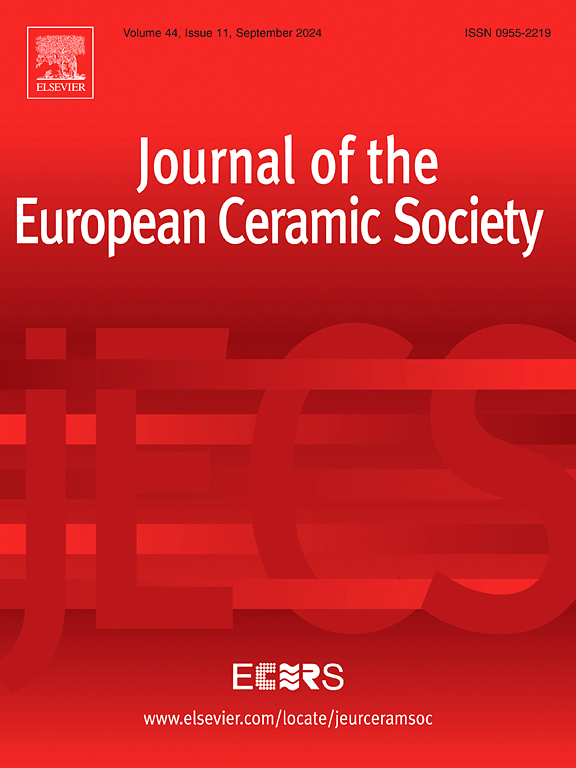Achieving near-theoretical transmittance in MgAl2O4 ceramic at reduced sintering temperature via solution substitution
IF 5.8
2区 材料科学
Q1 MATERIALS SCIENCE, CERAMICS
Journal of The European Ceramic Society
Pub Date : 2025-03-19
DOI:10.1016/j.jeurceramsoc.2025.117382
引用次数: 0
Abstract
Submicron-sized powders are ideal for large-scale industrial production of MgAl2O4 transparent ceramics, yet their low sintering activity limits the fabrication of high-quality products. Herein, we demonstrate that the sinterability of MgAl2O4 can be significantly improved through appropriate cation substitution. Specifically, by substituting 25 mol% Ga3+ for Al3+, the temperature required for completing pore closure by pressureless sintering was reduced by 125 °C (1450 °C) and the temperature for achieving near-theoretical transmittance via hot isostatic pressing post-treatment lowered by 300 °C (1500 °C). Such a marked effect may be attributed to the weakened octahedral bonding strength, which accelerates the formation and diffusion of oxygen vacancies upon sintering. Although excessive Ga3+ degrades intrinsic hardness, the MgAl1.5Ga0.5O4 ceramic obtained still reached a high hardness (∼13.62 GPa) due to its fine-grained microstructure, compared to the no Ga-addition counterpart. This study provides insights into the rational design of solid solutions with high sintering activity.
在降低烧结温度下,通过溶液取代实现MgAl2O4陶瓷接近理论的透光率
亚微米级粉末是大规模工业生产MgAl2O4透明陶瓷的理想材料,但其低烧结活性限制了高质量产品的制造。本文表明,通过适当的阳离子取代可以显著提高MgAl2O4的烧结性能。具体来说,用25 mol% Ga3+代替Al3+,通过无压烧结完成闭孔所需的温度降低了125°C(1450°C),通过热等静压后处理实现接近理论透过率的温度降低了300°C(1500°C)。这种显著的效应可能是由于八面体键合强度减弱,加速了烧结时氧空位的形成和扩散。虽然过量的Ga3+降低了固有硬度,但与未添加Ga3+的陶瓷相比,由于其细晶粒的微观结构,所获得的MgAl1.5Ga0.5O4陶瓷仍然达到了高硬度(~ 13.62 GPa)。该研究为高烧结活性固溶体的合理设计提供了新的思路。
本文章由计算机程序翻译,如有差异,请以英文原文为准。
求助全文
约1分钟内获得全文
求助全文
来源期刊

Journal of The European Ceramic Society
工程技术-材料科学:硅酸盐
CiteScore
10.70
自引率
12.30%
发文量
863
审稿时长
35 days
期刊介绍:
The Journal of the European Ceramic Society publishes the results of original research and reviews relating to ceramic materials. Papers of either an experimental or theoretical character will be welcomed on a fully international basis. The emphasis is on novel generic science concerning the relationships between processing, microstructure and properties of polycrystalline ceramics consolidated at high temperature. Papers may relate to any of the conventional categories of ceramic: structural, functional, traditional or composite. The central objective is to sustain a high standard of research quality by means of appropriate reviewing procedures.
 求助内容:
求助内容: 应助结果提醒方式:
应助结果提醒方式:


